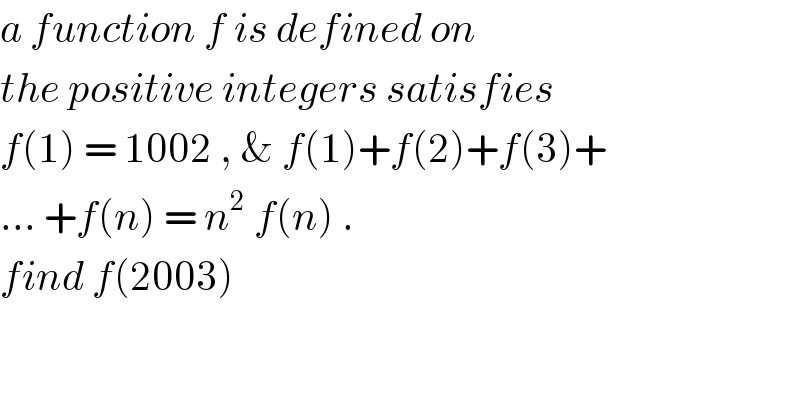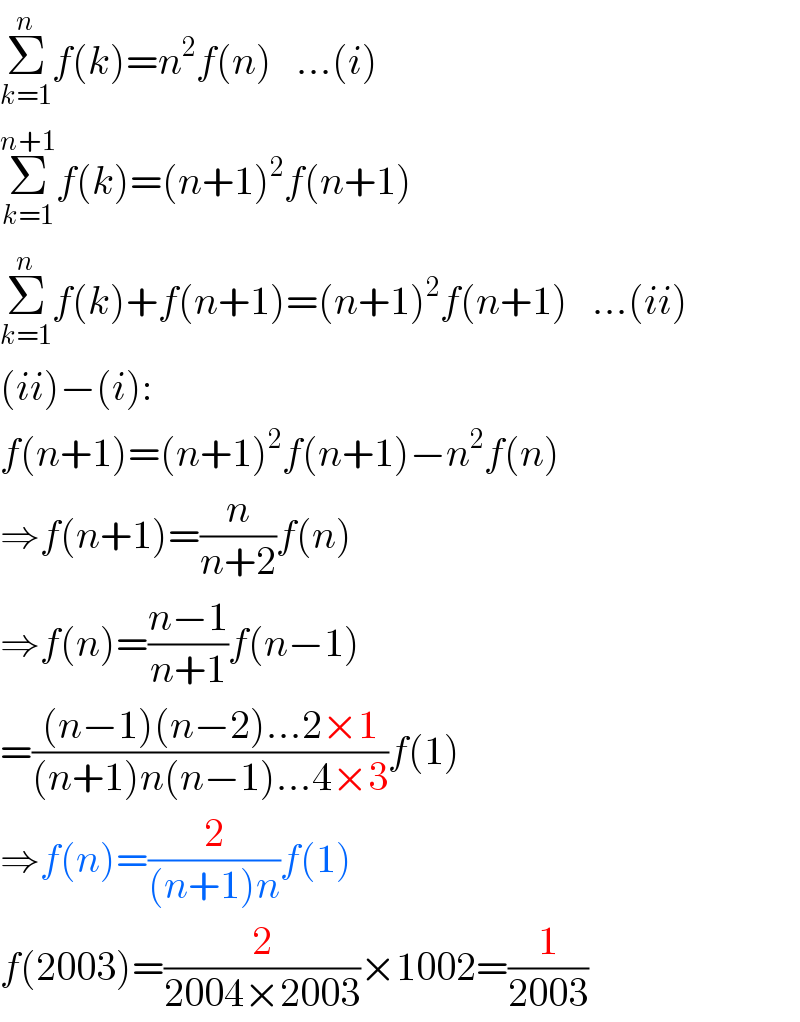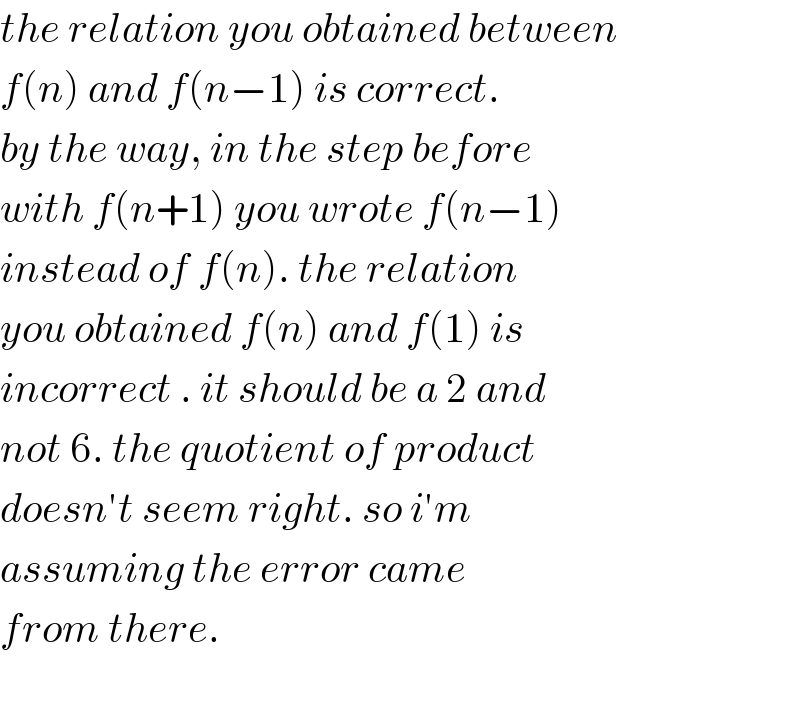
Previous in Relation and Functions Next in Relation and Functions
Question Number 90259 by john santu last updated on 22/Apr/20

$${a}\:{function}\:{f}\:{is}\:{defined}\:{on}\: \\ $$ $${the}\:{positive}\:{integers}\:{satisfies}\: \\ $$ $${f}\left(\mathrm{1}\right)\:=\:\mathrm{1002}\:,\:\&\:{f}\left(\mathrm{1}\right)+{f}\left(\mathrm{2}\right)+{f}\left(\mathrm{3}\right)+ \\ $$ $$...\:+{f}\left({n}\right)\:=\:{n}^{\mathrm{2}} \:{f}\left({n}\right)\:. \\ $$ $${find}\:{f}\left(\mathrm{2003}\right)\: \\ $$
Answered by mr W last updated on 22/Apr/20

$$\underset{{k}=\mathrm{1}} {\overset{{n}} {\sum}}{f}\left({k}\right)={n}^{\mathrm{2}} {f}\left({n}\right)\:\:\:...\left({i}\right) \\ $$ $$\underset{{k}=\mathrm{1}} {\overset{{n}+\mathrm{1}} {\sum}}{f}\left({k}\right)=\left({n}+\mathrm{1}\right)^{\mathrm{2}} {f}\left({n}+\mathrm{1}\right) \\ $$ $$\underset{{k}=\mathrm{1}} {\overset{{n}} {\sum}}{f}\left({k}\right)+{f}\left({n}+\mathrm{1}\right)=\left({n}+\mathrm{1}\right)^{\mathrm{2}} {f}\left({n}+\mathrm{1}\right)\:\:\:...\left({ii}\right) \\ $$ $$\left({ii}\right)−\left({i}\right): \\ $$ $${f}\left({n}+\mathrm{1}\right)=\left({n}+\mathrm{1}\right)^{\mathrm{2}} {f}\left({n}+\mathrm{1}\right)−{n}^{\mathrm{2}} {f}\left({n}\right) \\ $$ $$\Rightarrow{f}\left({n}+\mathrm{1}\right)=\frac{{n}}{{n}+\mathrm{2}}{f}\left({n}\right) \\ $$ $$\Rightarrow{f}\left({n}\right)=\frac{{n}−\mathrm{1}}{{n}+\mathrm{1}}{f}\left({n}−\mathrm{1}\right) \\ $$ $$=\frac{\left({n}−\mathrm{1}\right)\left({n}−\mathrm{2}\right)...\mathrm{2}×\mathrm{1}}{\left({n}+\mathrm{1}\right){n}\left({n}−\mathrm{1}\right)...\mathrm{4}×\mathrm{3}}{f}\left(\mathrm{1}\right) \\ $$ $$\Rightarrow{f}\left({n}\right)=\frac{\mathrm{2}}{\left({n}+\mathrm{1}\right){n}}{f}\left(\mathrm{1}\right) \\ $$ $${f}\left(\mathrm{2003}\right)=\frac{\mathrm{2}}{\mathrm{2004}×\mathrm{2003}}×\mathrm{1002}=\frac{\mathrm{1}}{\mathrm{2003}} \\ $$
Commented byjohn santu last updated on 22/Apr/20

$${the}\:{relation}\:{you}\:{obtained}\:{between}\: \\ $$ $${f}\left({n}\right)\:{and}\:{f}\left({n}−\mathrm{1}\right)\:{is}\:{correct}. \\ $$ $${by}\:{the}\:{way},\:{in}\:{the}\:{step}\:{before} \\ $$ $${with}\:{f}\left({n}+\mathrm{1}\right)\:{you}\:{wrote}\:{f}\left({n}−\mathrm{1}\right) \\ $$ $${instead}\:{of}\:{f}\left({n}\right).\:{the}\:{relation}\: \\ $$ $${you}\:{obtained}\:{f}\left({n}\right)\:{and}\:{f}\left(\mathrm{1}\right)\:{is} \\ $$ $${incorrect}\:.\:{it}\:{should}\:{be}\:{a}\:\mathrm{2}\:{and} \\ $$ $${not}\:\mathrm{6}.\:{the}\:{quotient}\:{of}\:{product}\: \\ $$ $${doesn}'{t}\:{seem}\:{right}.\:{so}\:{i}'{m}\: \\ $$ $${assuming}\:{the}\:{error}\:{came}\: \\ $$ $${from}\:{there}. \\ $$ $$ \\ $$
Commented byjohn santu last updated on 22/Apr/20

$${the}\:{answer}\:{is}\:\frac{\mathrm{1}}{\mathrm{2003}} \\ $$
Commented bymr W last updated on 22/Apr/20

$${now}\:{fixed}.\:{thanks}! \\ $$
